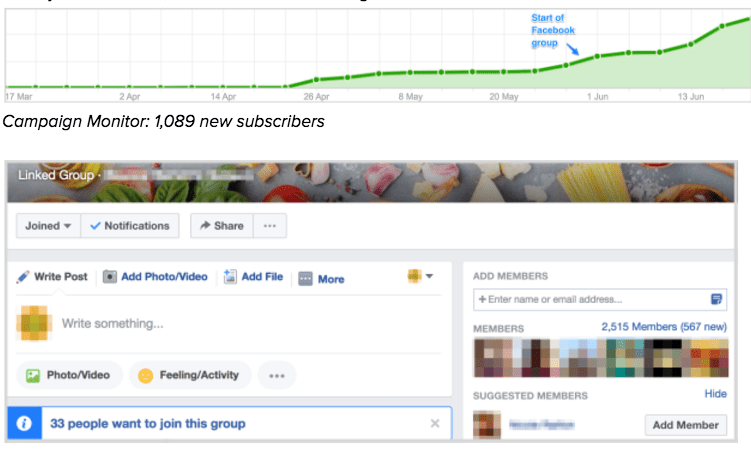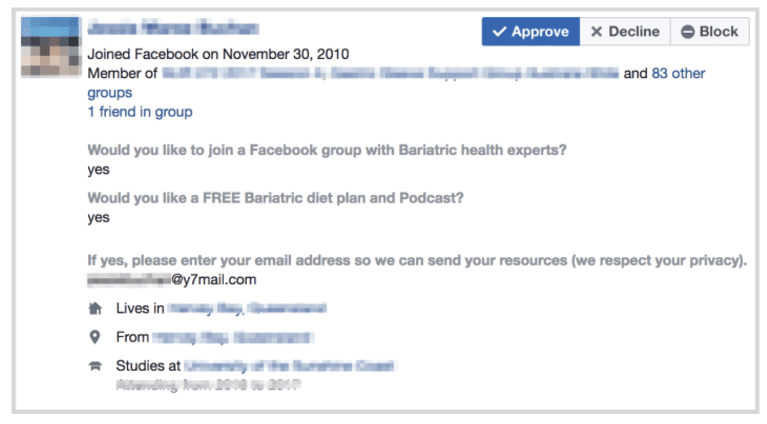How to get 1,000 emails addresses in 3 weeks with Facebook Groups
I’ve been watching Facebook marketing groups for quite some time. I’m amazed at both the supportiveness of these communities and also the engagement.
If you check out Mark Zuckerberg’s Facebook profile, some of his more recent posts such as the first ever Facebook Communities Summit and announcement of Facebook’s quarterly results make it clear they can see the value in these groups and want to develop this area more.
This year Facebook introduced some interesting features to groups. Here’s a quick overview:
- Linking Pages: linking your Facebook page with a group is a big one that many have been waiting for. All you need to do is add the ‘Groups’ tab to your page and then select ‘Link your Group’ and you’re ready to go. A major advantage for marketers with this new feature is posting to your customer base from the page without the need for customers communicating via your personal profile.
- Entry Questions: another is the ability to ask up to three questions upon entry to a group, giving the admin the ability to either accept or deny requests based on their submission.
- Linking Groups: and finally, a more recent feature is linking groups within groups. This is a good feature if you’re wanting to segment your following into more specialised areas.
I managed to get 1,000 email addresses in 3 weeks with the new Facebook group features
I decided to create my own Facebook group for a client and the results were pretty spectacular. I managed to get over 2.5K members and 1,000 email addresses all in a few weeks. Before I show you how I did it, here’s some humble-brag screenshots:

Campaign Monitor: 1,089 new subscribers
Facebook group: 2,515 members
Now that you believe I’m not talking out of my ass, let me show you how I did it…
Step 1: Who are your customers?
The first step is to identify who your customers are and do some market research into the types of Facebook groups they might hang out in. For my client, the customer base involved middle-aged women who were looking for a support network after they had undergone a particular weight loss surgery procedure.
Step 2: What are your customers motivated by?
This one can be a little tricky and can take some trial and error. For my client’s customer base, they wanted a space where they could ask questions and discover recipe ideas. My client agreed to take part in the community by answering questions without trying to sell to them (creating real value), and also put together a free resource that we could send members upon entry.
Step 3: Linking your Facebook page and deciding which questions to ask
You’ll need to link your Facebook page to the group in order to post as the page. In our case, we decided that the client would use their personal profile to interact with the community and the page to promote the business where appropriate. When asking your questions, try to evoke interest in the first question, provide a strong benefit in the second, and then your call-to-action with a privacy disclaimer in the final.
Step 4: Adding contact details to your marketing workflow
This part is a bit of a pain and requires some manual work. When members request access and have answered your set of questions, you’ll then need to store the relevant response details in a spreadsheet for upload to your workflow. Here’s an example of what a response looks like:

Step 5: Promote the group and keep the fire burning
This was probably the trickiest part of the whole process. Once you get some momentum it can soon fizzle out if you’re not giving your community a reason to stick around. My advice would be to position the group with the sole focus of having experts in the field contributing to the conversation – this is hard to come by in any open forum.
How marketers can use the new features
Once you’ve gained a decent following on the group and your email contacts list is looking healthy as ever, the possibilities are endless. Here’s some ideas I’ve been using:
- Develop genuine customer relationships to create fans of the brand
- Send educational material and new product promotions to their inbox
- Increase the following of the Facebook page
- Develop a lookalike audience campaign on Facebook with your email contacts
- Survey the community to get their feedback on what interests them most
If you have a business that works well on social media, feel free contact me and I can give you an idea for an approach to try.
 Brodie Clark is a Digital Campaign Manager at one of Melbourne’s leading SEO agencies, Optimising. Brodie has held both in-house and agency roles in Australia, developing digital strategy for a wide range of clients. When he isn’t in the office, you can find him writing on his personal blog over at BrodieClark.com. Follow him on Twitter or connect on Linkedin.
Brodie Clark is a Digital Campaign Manager at one of Melbourne’s leading SEO agencies, Optimising. Brodie has held both in-house and agency roles in Australia, developing digital strategy for a wide range of clients. When he isn’t in the office, you can find him writing on his personal blog over at BrodieClark.com. Follow him on Twitter or connect on Linkedin..









